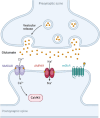AMPA Receptors in Synaptic Plasticity, Memory Function, and Brain Diseases
- PMID: 39841263
- PMCID: PMC11754374
- DOI: 10.1007/s10571-024-01529-7
AMPA Receptors in Synaptic Plasticity, Memory Function, and Brain Diseases
Abstract
Tetrameric AMPA-type ionotropic glutamate receptors are primary transducers of fast excitatory synaptic transmission in the central nervous system, and their properties and abundance at the synaptic surface are crucial determinants of synaptic efficacy in neuronal communication across the brain. The induction of long-term potentiation (LTP) leads to the insertion of GluA1-containing AMPA receptors at the synaptic surface, whereas during long-term depression (LTD), these receptors are internalized into the cytoplasm of the spine. Disruptions in the trafficking of AMPA receptors to and from the synaptic surface attenuate both forms of synaptic plasticity. Homeostatic scaling up and scaling down, which are additional types of plasticity similar to LTP and LTD, are also regulated by the insertion and removal of GluA1-containing AMPA receptors from the synaptic surface. The trafficking of AMPA receptors is an intricate process assisted by various proteins. Furthermore, AMPA receptors are critical for the formation and consolidation of various types of memory, and alterations in their function are intimately associated with cognitive dysfunction in aging and several neurological and psychiatric diseases. In this review, we will provide an overview of the current understanding of how AMPA receptors regulate various forms of synaptic plasticity, their contribution to memory functions, and their role in aging and brain diseases.
Keywords: AMPA receptors; Aging and neurological diseases; Homeostatic plasticity; LTP and LTD; Memory; Trafficking.
© 2025. The Author(s).
Conflict of interest statement
Declarations. Conflict of interest: The authors declare that there is no conflict of interest.
Figures






Similar articles
-
Control of Homeostatic Synaptic Plasticity by AKAP-Anchored Kinase and Phosphatase Regulation of Ca2+-Permeable AMPA Receptors.J Neurosci. 2018 Mar 14;38(11):2863-2876. doi: 10.1523/JNEUROSCI.2362-17.2018. Epub 2018 Feb 13. J Neurosci. 2018. PMID: 29440558 Free PMC article.
-
GluA1-homomeric AMPA receptor in synaptic plasticity and neurological diseases.Neuropharmacology. 2021 Oct 1;197:108708. doi: 10.1016/j.neuropharm.2021.108708. Epub 2021 Jul 15. Neuropharmacology. 2021. PMID: 34274350 Review.
-
The AMPA Receptor Code of Synaptic Plasticity.Neuron. 2018 Oct 24;100(2):314-329. doi: 10.1016/j.neuron.2018.10.018. Neuron. 2018. PMID: 30359599 Free PMC article. Review.
-
Ubiquitination of the GluA1 Subunit of AMPA Receptors Is Required for Synaptic Plasticity, Memory, and Cognitive Flexibility.J Neurosci. 2023 Jul 26;43(30):5448-5457. doi: 10.1523/JNEUROSCI.1542-22.2023. Epub 2023 Jul 7. J Neurosci. 2023. PMID: 37419688 Free PMC article.
-
AKAP150-anchored calcineurin regulates synaptic plasticity by limiting synaptic incorporation of Ca2+-permeable AMPA receptors.J Neurosci. 2012 Oct 24;32(43):15036-52. doi: 10.1523/JNEUROSCI.3326-12.2012. J Neurosci. 2012. PMID: 23100425 Free PMC article.
Cited by
-
Glutamate-Based Therapeutic Strategies for Schizophrenia: Emerging Approaches Beyond Dopamine.Int J Mol Sci. 2025 May 2;26(9):4331. doi: 10.3390/ijms26094331. Int J Mol Sci. 2025. PMID: 40362567 Free PMC article. Review.
-
The Role of Astrocytes in Synaptic Dysfunction and Memory Deficits in Alzheimer's Disease.Biomolecules. 2025 Jun 20;15(7):910. doi: 10.3390/biom15070910. Biomolecules. 2025. PMID: 40723783 Free PMC article. Review.
-
Beta-hydroxybutyrate counteracts the deleterious effects of a saturated high-fat diet on synaptic AMPAR receptors and cognitive performance.Mol Metab. 2025 Sep;99:102207. doi: 10.1016/j.molmet.2025.102207. Epub 2025 Jul 6. Mol Metab. 2025. PMID: 40628351 Free PMC article.
-
Extracellular Vesicles from Peripheral Blood Mononuclear Cells of Hyperammonemic Rats Induce Neuroinflammation in Hippocampus, Impairing Memory and Learning in Normal Rats.J Neuroimmune Pharmacol. 2025 Jun 7;20(1):65. doi: 10.1007/s11481-025-10225-2. J Neuroimmune Pharmacol. 2025. PMID: 40481977 No abstract available.
-
Cancer-nervous system crosstalk: from biological mechanism to therapeutic opportunities.Mol Cancer. 2025 May 5;24(1):133. doi: 10.1186/s12943-025-02336-4. Mol Cancer. 2025. PMID: 40320550 Free PMC article. Review.
References
-
- Alberi S, Boda B, Steiner P et al (2005) The endosomal protein NEEP21 regulates AMPA receptor-mediated synaptic transmission and plasticity in the hippocampus. Mol Cell Neurosci 29:313–319. 10.1016/j.mcn.2005.03.011 - PubMed
Publication types
MeSH terms
Substances
Grants and funding
LinkOut - more resources
Full Text Sources
Medical

